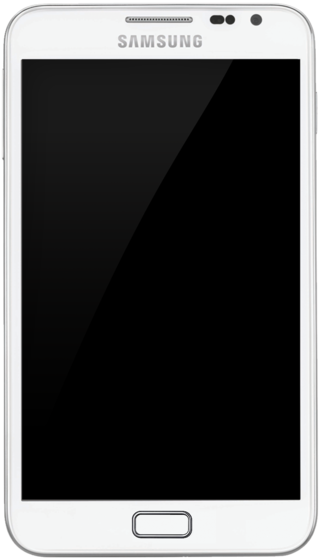
A wearable computer, also known as a body-borne computer, is a computing device worn on the body. The definition of 'wearable computer' may be narrow or broad, extending to smartphones or even ordinary wristwatches.

A smartphone is a mobile device that combines the functionality of a traditional mobile phone with advanced computing capabilities. It typically has a touchscreen interface, allowing users to access a wide range of applications and services, such as web browsing, email, and social media, as well as multimedia playback and streaming. Smartphones have built-in cameras, GPS navigation, and support for various communication methods, including voice calls, text messaging, and internet-based messaging apps.

Mobile computing is human–computer interaction in which a computer is expected to be transported during normal usage and allow for transmission of data, which can include voice and video transmissions. Mobile computing involves mobile communication, mobile hardware, and mobile software. Communication issues include ad hoc networks and infrastructure networks as well as communication properties, protocols, data formats, and concrete technologies. Hardware includes mobile devices or device components. Mobile software deals with the characteristics and requirements of mobile applications.

A mobile device, also referred to as a digital assistant, is a computer small enough to hold and operate in the hand. Mobile devices typically have a flat LCD or OLED screen, a touchscreen interface, and digital or physical buttons. They may also have a physical keyboard. Many mobile devices can connect to the Internet and connect with other devices, such as car entertainment systems or headsets, via Wi-Fi, Bluetooth, cellular networks, or near-field communication. Integrated cameras, the ability to place and receive voice and video telephone calls, video games, and Global Positioning System (GPS) capabilities are common. Power is typically provided by a lithium-ion battery. Mobile devices may run mobile operating systems that allow third-party applications to be installed and run.

A camera phone is a mobile phone which is able to capture photographs and often record video using one or more built-in digital cameras. It can also send the resulting image wirelessly and conveniently. The first commercial phone with color camera was the Kyocera Visual Phone VP-210, released in Japan in May 1999.

Electronic news gathering (ENG) or electronic journalism (EJ) is usage of electronic video and audio technologies by reporters to gather and present news instead of using film cameras. The term was coined during the rise of videotape technology in the 1970s. ENG can involve anything from a single reporter with a single professional video camera, to an entire television crew taking a truck on location.
Mobile television is television watched on a small handheld or mobile device, typically developed for that purpose. It includes service delivered via mobile phone networks, received free-to-air via terrestrial television stations, or via satellite broadcast. Regular broadcast standards or special mobile TV transmission formats can be used. Additional features include downloading TV programs and podcasts from the Internet and storing programming for later viewing.
Mobile blogging is a method of publishing to a website or blog from a mobile phone or other handheld device. A moblog helps habitual bloggers to post write-ups directly from their phones even when on the move. Mobile blogging has been made possible by technological convergence, as bloggers have been able to write, record and upload different media all from a single, mobile device. At the height of its growth in 2006, mobile blogging experienced 70,000 blog creations a day and 29,100 blog posts an hour. Between 2006 and 2010, blogging among teens declined from 28% to 14%, while blogging among adults over 30 increased from 7% to 11%. However, the growing number of multi-platform blogging apps has increased mobile blogging popularity in recent years creating a brand new market that many celebrities, regular bloggers and specialists are utilizing to widen their social reach.
The Nokia 7650 is a 2.5G consumer-oriented mobile phone belonging to the fashion and experimental (7xxx) series. It was introduced in Barcelona on 19 November 2001, and was described by CEO Jorma Ollila as the company's most important launch of that year.

A mobile phone is a portable telephone that can make and receive calls over a radio frequency link while the user is moving within a telephone service area, as opposed to a fixed-location phone. The radio frequency link establishes a connection to the switching systems of a mobile phone operator, which provides access to the public switched telephone network (PSTN). Modern mobile telephone services use a cellular network architecture, and therefore mobile telephones are called cellphones in North America. In addition to telephony, digital mobile phones support a variety of other services, such as text messaging, multimedia messaging, email, Internet access, short-range wireless communications, satellite access, business applications, payments, multimedia playback and streaming, digital photography, and video games. Mobile phones offering only basic capabilities are known as feature phones ; mobile phones that offer greatly advanced computing capabilities are referred to as smartphones.

A feature phone is a type or class of mobile phone that retains the form factor of earlier generations of mobile telephones, typically with press-button based inputs and a small non-touch display. They tend to use an embedded operating system with a small and simple graphical user interface, unlike large and complex mobile operating systems such as Android from Google or iOS from Apple.

The Nokia Nseries was a high-end lineup of feature phones, smartphones, and tablets marketed by Nokia Corporation from 2005 to 2011. The Nseries devices commonly supported multiple high-speed wireless technologies at the time, such as 3G, or Wireless LAN. Digital multimedia services, such as music playback, photo/video capture or viewing, gaming or internet services were the central focus of the lineup. The lineup was replaced in 2011 by the Nokia Lumia line as the company's primary smartphone lineup.

The Samsung Galaxy Note is an Android smartphone produced by Samsung Electronics. It was unveiled at IFA Berlin 2011 and first released in Germany in late October 2011, with other countries following afterwards. The Galaxy Note was distinguished by its unusually large form factor—later referred to using the term "phablet"—which straddled the size of the average smartphone at the time, and that of a small tablet: it features a 5.3-inch display, and is bundled with a stylus branded as the "S Pen", which can be used to navigate the device's user interface, and write or draw in supported apps.

Orbot is a free proxy app that provides anonymity on the Internet for users of the Android and iOS operating systems. It allows traffic from apps such as web browsers, email clients, map programs, and others to be routed via the Tor network.

Allissa V. Richardson is an American journalist and college professor. She is best known as a proponent of mobile journalism and citizen journalism. Richardson has trained students in the United States and Africa to report news using only smartphones, tablets and MP3 players. She is assistant professor of journalism in the Annenberg School for Communication and Journalism at the University of Southern California. Additionally, Richardson is a Nieman Foundation Visiting Journalism Fellow at Harvard University, the 2012 Educator of the Year for the National Association of Black Journalists, and a two-time Apple Distinguished Educator.
A microphone blocker is a phone microphone connector used to trick feature phones that have a physical microphone switch to disconnect the microphone. Microphone blockers won't operate on smartphones or laptops because the microphone is controlled with software rather than a physical switch.
/e/ is a fork of LineageOS, an Android-based mobile operating system, and associated online services. /e/ is presented as privacy software that does not contain proprietary Google apps or services, and challenges the public to "find any parts of the system or default applications that are still leaking data to Google."

GrapheneOS is an Android-based, open source, privacy and security-focused mobile operating system for selected Google Pixel devices, including smartphones, tablets and foldables that is recommended by Edward Snowden.
The Umidigi A9, A9 Pro, and A9 Max are Android smartphones sold by Umidigi. Unveiled in December 2020, they are a family of entry-level smartphones.

Emmanuel Kwasi Debrah also known as Kwasi Debrah, is a multimedia journalist working with Multimedia Group Limited in Ghana. He is the lead for the KNUST and Multimedia Group Limited Medical Journalism programme.














